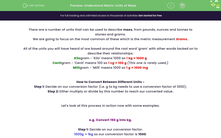There are a number of units that can be used to describe mass, from pounds, ounces and tonnes to stones and grams.
We are going to focus on the most common of these which is the metric measurement grams.
All of the units you will have heard of are based around the root word 'gram' with other words tacked on to describe their relationships:
Kilogram - 'Kilo' means 1000 so 1 kg = 1,000 g
Centigram - 'Centi' means 100 so 1 cg = 100 g (This one is rarely used.)
Milligram - 'Milli' means 1000 so 1 g = 1,000 mg
How to Convert Between Different Units
Step 1: Decide on our conversion factor (i.e. g to kg needs to use a conversion factor of 1,000)
Step 2: Either multiply or divide by this number to reach our converted value.
Let's look at this process in action now with some examples.
e.g. Convert 150 g into kg.
Step 1: Decide on our conversion factor.
1,000 g = 1 kg so our conversion factor is 1,000.
Step 2: Multiply or divide by this conversion factor.
We need to think about this a little to decide whether to multiply or divide.
One way to look at this is that a kilogram is bigger than a gram, so there needs to be fewer of them overall.
As there needs to be fewer of them, we need to divide:
150 ÷ 1,000 = 0.15 kg
e.g. Convert 280 g into milligrams.
Step 1: Decide on our conversion factor.
1,000 mg = 1 g so our conversion factor is 1,000.
Step 2: Multiply or divide by this conversion factor.
A milligram is smaller than a gram, so there will need to be more of them overall.
As there needs to be more of them, we need to multiply:
280 × 1,000 = 280,000 mg
In this activity, we will practise converting between the four units of mass measurement described above (kilogram, centigram, milligram and gram) using the method we have seen in action here.








